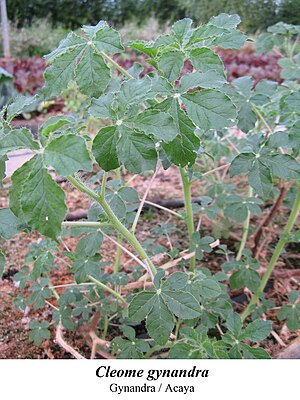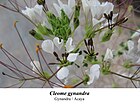Note: This is a project under development. The articles on this wiki are just being initiated and broadly incomplete. You can Help creating new pages.
Difference between revisions of "Cleome gynandra - Ajagandha"
m (Prabhakar moved page Cleome gynandra Linn - Ajagandha to Cleome gynandra - Ajagandha) |
|||
| (2 intermediate revisions by the same user not shown) | |||
| Line 1: | Line 1: | ||
| − | |||
[[File:Cleome gynandra 2.jpg|thumb|right|]] | [[File:Cleome gynandra 2.jpg|thumb|right|]] | ||
| − | '''Ajagandhā''' | + | '''Ajagandhā''' a strong smelling, somewhat foetid herb. It grows upto 0.6 - 1 m tall. It can found abundantly throughout warmer parts of India. |
| − | |||
==Uses== | ==Uses== | ||
{{Uses|Mouth sores}}, {{Uses|Bleeding piles}}, {{Uses|Leucorrhoea}}, {{Uses|Mild diabetes}}, {{Uses|Cough}}, {{Uses|Physical weakness}}, {{Uses|Ulcer}}, {{Uses|Urinary trouble}}, {{Uses|Snakebite}}, {{Uses|Infection in intestine}}. | {{Uses|Mouth sores}}, {{Uses|Bleeding piles}}, {{Uses|Leucorrhoea}}, {{Uses|Mild diabetes}}, {{Uses|Cough}}, {{Uses|Physical weakness}}, {{Uses|Ulcer}}, {{Uses|Urinary trouble}}, {{Uses|Snakebite}}, {{Uses|Infection in intestine}}. | ||
| + | |||
| + | ===Food=== | ||
| + | Ajagandha can be used in food. Leaves are used as a fl avoring agent and are cooked as vegetable. They are slightly bitter but cooking removes bitterness. | ||
==Parts Used== | ==Parts Used== | ||
| Line 30: | Line 31: | ||
===Prabhava=== | ===Prabhava=== | ||
| + | |||
| + | ===Nutritional components=== | ||
| + | Ajagandha Contains the Following nutritional components like - 7-phenoxycoumarine, Diterpene lactone, Myristic, Palmitic acid, Steric, Oleic, | ||
| + | Linoleic acid; Calcium, Iron, Magnesium, Manganese, Phosphorus, Potassium, Sodium, Zinc<ref name="Nutritional components"/> | ||
==Habit== | ==Habit== | ||
| Line 39: | Line 44: | ||
===Flower=== | ===Flower=== | ||
| − | {{Flower|Bisexual|1.5 cm across| | + | {{Flower|Bisexual|1.5 cm across|White|5|Flowering throughout the year and In terminal and/or axillary pseudoracemes calyx lobes unequal, glandular, pubescent; petals long clawed, spreading; stamens 6, attached to the long gynandrophore; ovary glandular.}} |
===Fruit=== | ===Fruit=== | ||
| − | {{Fruit|Capsule| 3-4 cm long terete, glandular, tip discoid.||| | + | {{Fruit|Capsule| 3-4 cm long terete, glandular, tip discoid.|||Seeds upto 5|Fruiting throughout the year}} |
===Other features=== | ===Other features=== | ||
| Line 56: | Line 61: | ||
{{Propagation|Seeds}} | {{Propagation|Seeds}} | ||
| − | == | + | ==Cultivation Details== |
| − | Seed - surface sow or only lightly cover the seed in spring in a greenhouse. The seed usually germinates in 5 - 14 days at 25 <ref name="Cultivation details"/> | + | Seed - surface sow or only lightly cover the seed in spring in a greenhouse. The seed usually germinates in 5 - 14 days at 25. Ajagandha is available from June to October<ref name="Cultivation details"/> |
==Commonly seen growing in areas== | ==Commonly seen growing in areas== | ||
| Line 73: | Line 78: | ||
==References== | ==References== | ||
| − | |||
<references> | <references> | ||
| − | <ref name="chemical composition">[http://www.ayurveda.hu/api/API-Vol-1.pdf Ayurvedic Pharmacopoeia of India Vol-2 | + | <ref name="chemical composition">[http://www.ayurveda.hu/api/API-Vol-1.pdf Ayurvedic Pharmacopoeia of India Vol-2 Chemistry]</ref> |
<ref name="Leaf">FLOWERING PLANTS OF KERALA VER 2.0, N.SASIDHARAN </ref> | <ref name="Leaf">FLOWERING PLANTS OF KERALA VER 2.0, N.SASIDHARAN </ref> | ||
| − | <ref name="Cultivation details">[https://pfaf.org/user/Plant.aspx?LatinName=Cleome+gynandra | + | <ref name="Cultivation details">[https://pfaf.org/user/Plant.aspx?LatinName=Cleome+gynandra Cultivation details]</ref> |
| − | <ref name="Ayurvedic preparations">[https://easyayurveda.com/2015/04/17/ajagandha-uses-research-dose-side-effects/ | + | <ref name="Ayurvedic preparations">[https://easyayurveda.com/2015/04/17/ajagandha-uses-research-dose-side-effects/ Ayurvedic preparations]</ref> |
| − | + | <ref name="Nutritional components">Forest food for Northern region of western ghat pdf by Dr. Mandar N. Datar and Dr. Anuradha S. Upadhye, MACS - Agharkar Research Institute, Pune</ref> | |
</references> | </references> | ||
Latest revision as of 17:51, 18 October 2021
Ajagandhā a strong smelling, somewhat foetid herb. It grows upto 0.6 - 1 m tall. It can found abundantly throughout warmer parts of India.
Contents
- 1 Uses
- 2 Parts Used
- 3 Chemical Composition
- 4 Common names
- 5 Properties
- 6 Habit
- 7 Identification
- 8 List of Ayurvedic medicine in which the herb is used
- 9 Where to get the saplings
- 10 Mode of Propagation
- 11 Cultivation Details
- 12 Commonly seen growing in areas
- 13 Photo Gallery
- 14 References
- 15 External Links
Uses
Mouth sores, Bleeding piles, Leucorrhoea, Mild diabetes, Cough, Physical weakness, Ulcer, Urinary trouble, Snakebite, Infection in intestine.
Food
Ajagandha can be used in food. Leaves are used as a fl avoring agent and are cooked as vegetable. They are slightly bitter but cooking removes bitterness.
Parts Used
Chemical Composition
Fixed oil, essential oil, oleoresin, Carotenoids, Cardiac glycosides, Cyanogenic Glycosides, Flavonoids, Saponins, Triterpenes, sugars, Tannins etc.[1]
Common names
| Language | Common name |
|---|---|
| Kannada | Naram bele Soppu, Nayeetulasi |
| Hindi | Hulhul, Hurhur, Kavalia |
| Malayalam | Atunari vela |
| Tamil | Nal valai, Nal velai |
| Telugu | Vaminta, Vayinta |
| Marathi | Tilvan, Bhatvan, Mabli, Tilavana, Tilvant |
| Gujarathi | Talvani, Dhelitalavan |
| Punjabi | Bugra |
| Kashmiri | Gandi Buti |
| Sanskrit | Pashughandha |
| English | Dog Mustard |
Properties
Reference: Dravya - Substance, Rasa - Taste, Guna - Qualities, Veerya - Potency, Vipaka - Post-digesion effect, Karma - Pharmacological activity, Prabhava - Therepeutics.
Dravya
Rasa
Katu (Pungent)
Guna
Laghu (Light), Ruksha (Dry)
Veerya
Sheeta (Cold)
Vipaka
Katu (Pungent)
Karma
Kaphahara, Vatahara, Deepana, Hridya
Prabhava
Nutritional components
Ajagandha Contains the Following nutritional components like - 7-phenoxycoumarine, Diterpene lactone, Myristic, Palmitic acid, Steric, Oleic, Linoleic acid; Calcium, Iron, Magnesium, Manganese, Phosphorus, Potassium, Sodium, Zinc[2]
Habit
Identification
Leaf
| Kind | Shape | Feature |
|---|---|---|
| Digitate | Alternate | Leaf Arrangementis Alternate-spiralLeaves digitately 5-7 foliate; leaflets 5 x 2.5 cm, obovate; petiole 3-15 cm. |
Flower
| Type | Size | Color and composition | Stamen | More information |
|---|---|---|---|---|
| Bisexual | 1.5 cm across | White | 5 | Flowering throughout the year and In terminal and/or axillary pseudoracemes calyx lobes unequal, glandular, pubescent; petals long clawed, spreading; stamens 6, attached to the long gynandrophore; ovary glandular. |
Fruit
| Type | Size | Mass | Appearance | Seeds | More information |
|---|---|---|---|---|---|
| Capsule | 3-4 cm long terete, glandular, tip discoid. | Seeds upto 5 | Fruiting throughout the year |
Other features
List of Ayurvedic medicine in which the herb is used
Where to get the saplings
Mode of Propagation
Cultivation Details
Seed - surface sow or only lightly cover the seed in spring in a greenhouse. The seed usually germinates in 5 - 14 days at 25. Ajagandha is available from June to October[5]
Commonly seen growing in areas
Open areas, Waste places, Cultivated and Uncultivated land.
Photo Gallery
References
- ↑ Ayurvedic Pharmacopoeia of India Vol-2 Chemistry
- ↑ Forest food for Northern region of western ghat pdf by Dr. Mandar N. Datar and Dr. Anuradha S. Upadhye, MACS - Agharkar Research Institute, Pune
- ↑ FLOWERING PLANTS OF KERALA VER 2.0, N.SASIDHARAN
- ↑ Ayurvedic preparations
- ↑ Cultivation details
External Links
- Ayurvedic Herbs known to be helpful to treat Mouth sores
- Ayurvedic Herbs known to be helpful to treat Bleeding piles
- Ayurvedic Herbs known to be helpful to treat Leucorrhoea
- Ayurvedic Herbs known to be helpful to treat Mild diabetes
- Ayurvedic Herbs known to be helpful to treat Cough
- Ayurvedic Herbs known to be helpful to treat Physical weakness
- Ayurvedic Herbs known to be helpful to treat Ulcer
- Ayurvedic Herbs known to be helpful to treat Urinary trouble
- Ayurvedic Herbs known to be helpful to treat Snakebite
- Ayurvedic Herbs known to be helpful to treat Infection in intestine
- Herbs with Seeds used in medicine
- Herbs with Stem used in medicine
- Herbs with Leaves used in medicine
- Herbs with Roots used in medicine
- Herbs with common name in Kannada
- Herbs with common name in Hindi
- Herbs with common name in Malayalam
- Herbs with common name in Tamil
- Herbs with common name in Telugu
- Herbs with common name in Marathi
- Herbs with common name in Gujarathi
- Herbs with common name in Punjabi
- Herbs with common name in Kashmiri
- Herbs with common name in Sanskrit
- Herbs with common name in English
- Habit - Annual Erect
- Index of Plants which can be propagated by Seeds
- Herbs that are commonly seen in the region of Open areas
- Herbs that are commonly seen in the region of Waste places
- Herbs that are commonly seen in the region of Cultivated and Uncultivated land
- Ayurvedic Pharmacopedia of India
- Herbs
- Cleomaceae






